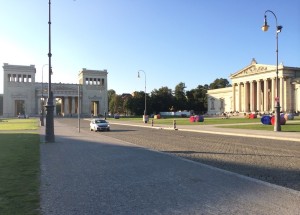Works of Russian artist Wassily Kandinsky, who lived and worked in Munich at the turn of XIX-XX centuries, are appreciated not only in this city, but all over Germany. I have personally seen reproductions of his paintings in many offices and private German homes. Indeed, he had a significant influence on the modern German school of painting, and the group of expressionist artists “The Blue Rider” (Der Blaue Reiter) organized by him in Munich is known worldwide. The largest collection of paintings by Kandinsky is exhibited in the Lenbachhaus gallery, which is located near the Königsplatz square. One can get there by U-Bahn, the Königsplatz station.
 The Lenbachhaus gallery is located in a luxury villa, once belonged to the famous German artist Franz von Lenbach. The villa is an architectural masterpiece built in the Florentine style. The modern wing, where the main entrance is located, looks rather primitive adjacent to the villa. The collection of Kandinsky and The Blue Rider group works occupy almost the entire third floor of the museum. It includes dozens of paintings by Kandinsky himself as well as by his best student and long-time girlfriend Gabriele Münter. Not being a great arts connoisseur, I know, nevertheless, that Kandinsky was one of the founders of the abstract art. Its essence is to ensure that the painting conveys a game of color and shapes that evoke different associations. Therefore, anyone can try their own way to comprehend the work of the artist.
The Lenbachhaus gallery is located in a luxury villa, once belonged to the famous German artist Franz von Lenbach. The villa is an architectural masterpiece built in the Florentine style. The modern wing, where the main entrance is located, looks rather primitive adjacent to the villa. The collection of Kandinsky and The Blue Rider group works occupy almost the entire third floor of the museum. It includes dozens of paintings by Kandinsky himself as well as by his best student and long-time girlfriend Gabriele Münter. Not being a great arts connoisseur, I know, nevertheless, that Kandinsky was one of the founders of the abstract art. Its essence is to ensure that the painting conveys a game of color and shapes that evoke different associations. Therefore, anyone can try their own way to comprehend the work of the artist.
Kandinsky lived in Munich for 20 years; he studied painting and later organized here his school of the new abstract art direction. The Blue Rider group organized by him included both German and Russian artists. Works of many of them, like Franz Marc, August Macke, Marianne Werefkin, Alexei Jawlensky and others, are represented in the Lenbachhaus gallery.
As for the other exhibits in the gallery, they mainly represent works by German (primarily Munich’s) artists of the XVIII-XX centuries. We were particularly impressed by the large and colorful paintings of the second half of the XX century. They are intended, apparently, to decorate modern living interiors. We also liked several installations with backlights, which are probably intended for offices and non-ordinary private houses, or maybe have some other applications. In general, there are lots of interesting exhibits in the gallery, although for us the main thing was still Kandinsky and his group.
Share on:
 Munich Insider Tips and advice from Munich residents for self-guided tours and trips
Munich Insider Tips and advice from Munich residents for self-guided tours and trips



